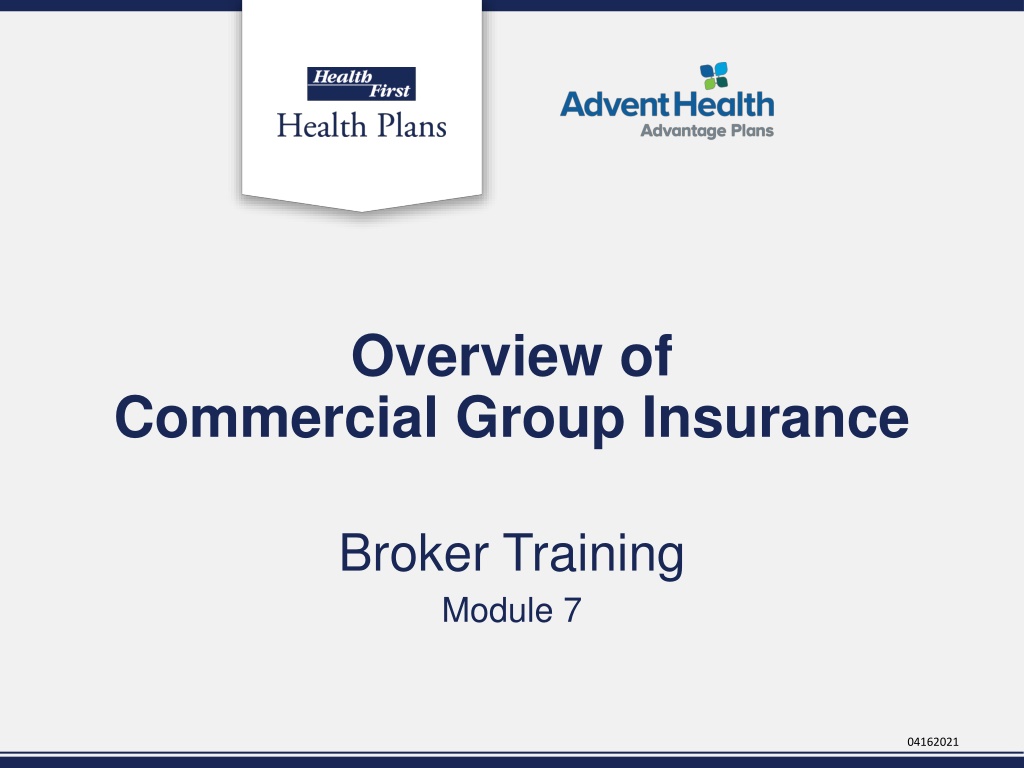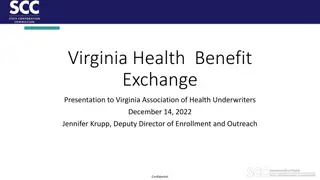Commercial Group Insurance Broker Training Module Overview
This training module provides a comprehensive overview of the Commercial Group Insurance market, focusing on Health First Health Plans and AdventHealth Advantage Plans. It covers employer programs, dependent eligibility, enrollment periods, plan exclusions, provider networks, terminology, and more. Additionally, it explains the differences between fully insured and self-insured employer group insurance policies.
Download Presentation

Please find below an Image/Link to download the presentation.
The content on the website is provided AS IS for your information and personal use only. It may not be sold, licensed, or shared on other websites without obtaining consent from the author. Download presentation by click this link. If you encounter any issues during the download, it is possible that the publisher has removed the file from their server.
E N D
Presentation Transcript
Overview of Commercial Group Insurance Broker Training Module 7 04162021
Module Description This module is designed to explain: A broad overview of the Commercial Group Insurance market as it relates to Health First Health Plans and AdventHealth Advantage Plans The types of employer programs offered and corresponding counties General dependent eligibility Enrollment periods Continuation of coverage Plan exclusions Provider wrap networks High Value Network Common terminology
Employer Group Insurance A group health insurance policy is typically purchased by an employer and is offered to eligible participants, and to eligible dependents of participants.
Employer Group Insurance Self-Insured Fully Insured Health First Health Plans becomes the Third-Party Administrator (TPA)/Administrative Services Only (ASO) and is hired to perform administrative services such as: Customer Service Claims Medical Management Employer group pays Health First Health Plans monthly premium based on the number of employees enrolled in the plan The employer group makes rules about benefits and exclusions. Federal guidelines apply; however, state rules may not In exchange for the premium, Health First Health Plans makes rules about benefits and exclusions, and covers employees and covered dependents, minus their cost sharing for all covered services Employer group assumes financial risk Health First Health Plans assumes the financial risk Checks to providers come from Health First Health Plans, not the employer group funds Checks to providers come from employer s group fund, not Health First Health Plans
Fully Insured Group Insurance Fully Insured Groups can be categorized as either: Small Group: Coverage for a group of 2-50 employees (subscribers) and their eligible dependents Large Group: Coverage for a group of 51+ employees (subscribers) and their eligible dependents Fully Insured large groups that insure more than 100 employees may have customer-specific plans customized at the employer s request; however, often carry additional premium.
Commercial Group Sales Territory and Plan Type AdventHealth Advantage Plans Health First Health Plans Brevard County HMO POS Access POS Third-Party Administration (TPA) / Administrative Services Only (ASO) Volusia and Flagler Counties HMO POS Third-Party Administration (TPA) / Administrative Services Only (ASO)
General Dependent Eligibility Spouse: Must be a lawful spouse Small groups include coverage for a domestic partner Large groups can elect to add a rider for domestic partner coverage Dependent Child: Any child who is one of the following: Natural-born child Stepchild Child through legal guardianship Foster child Legally adopted child Children are covered through the end of the calendar year in which they reach age 26 without restrictions Coverage can be extended through the end of the calendar year in which the child reaches age 30 if the child: is a state resident or full-time or part-time student, AND they do not have other health insurance coverage, AND is unmarried without dependents of their own NOTE: A newborn child of a covered dependent child is considered an eligible dependent. Coverage for such newborn child will automatically terminate eighteen (18) months after the birth of the newborn child.
Enrollment Periods Special Enrollment Period (SEP) Provided for special circumstances Initial Enrollment Period (IEP) Span of time during which an employee or dependent is first eligible to enroll Open Enrollment Period (OEP) Annual period beginning 30 or 31 days prior to the anniversary date of the employer s program Examples of qualifying events: Marriage Birth, adoption Loss of other coverage Employment status change Begins on initial date of eligibility and ends 31 days later If enrollment form is not received within the allotted timeframe, it may be denied, and employee may have to wait until the next OEP to enroll
Enrollment Procedure & Effective Dates Enrollment Procedure Eligible employee enrolls through their employer, using a Health First Health Plans/AdventHealth Advantage Plans approved enrollment form, spreadsheet, group-specific form, or employer portal submission Effective Dates Depends on when the employee enrolls Group s effective date Date the employee becomes eligible (Initial Enrollment Period) Date of qualifying event (Special Enrollment Period) Anniversary date (Open Enrollment Period)
Continuation of Coverage When a member becomes ineligible to continue their group insurance, they do have the right to continue coverage. There are two options based on employer group size: Florida Health Insurance Coverage Continuation Act (FHICCA or State Continuation) Groups with 2-19 employees Consolidated Omnibus Budget Reconciliation Act (COBRA) Groups with 20+ employees
FHICCA Florida Health Insurance Coverage Continuation Act Provided under state law and follows state guidelines Coverage is identical to the coverage provided under the plan as an active employee Health First Health Plans administers the plan benefits and collects the premium from the member, not the group Premium = 115% of plan premium as active employee Can be covered up to: 18 months with a qualifying event 29 months if disabled Relationship is still tied to the employer group If group changes health coverage for active employees, the FHICCA member coverage will change as well
COBRA Consolidated Omnibus Budget Reconciliation Act Provided under federal law and follows federal guidelines Coverage is identical to the coverage provided under the plan as an active employee Heath First Health Plans does NOT administer COBRA for employer groups The group may contract their own administrator The group or COBRA administrator is responsible for member enrollment/disenrollment and payment of premium Can be covered up to: 18 months with a qualifying event 29 months if disabled 36 months for other select qualifying events Relationship is still tied to the employer group If group changes health coverage for active employees, the COBRA member coverage will change as well
Plan Exclusions Procedures deemed not medically necessary are not covered. Exclusions and limitations are interpreted by the plans and listed in the subscriber contract. Common examples: Alcohol/drug-related injuries Alternative medicine treatments Bariatric surgery (large group rider available) Complications of non-covered services Custodial care Cosmetic surgery Gender reassignment services Hearing aids Infertility Residential Treatment Facility Vision therapy
Wrap Network / Expanded Network First Health is a nationally managed care program that offers expanded network coverage to help support the evolving needs of our members View the First Health national provider network at FirstHealthComplementary.com Members on an Access Plan or Out of Area Employee Rider benefit from in- network cost share while using First Health providers. Small and Large Group POS members are protected from balance billing and benefit from our contract pricing with First Health.
High Value Network Plans Benefits of the HVN Offer the same comprehensive benefits at a lower monthly premium No referrals or extra prior authorization Pay a lower cost share when seeing a provider (or using a facility) within the Health First Health Plans High Value Network Lower prescription drug copays when prescriptions are filled at pharmacies in the Preferred Value Network What is the Difference Between HVN and PVN? Pharmacy: The Preferred Value Network (PVN) is a network of pharmaciesthat offers reduced prescription drug copays or coinsurances to HNV member so they can save money on prescriptions. Medical: Health First Health Plans High Value Network (HVN) is composed of Health First hospitals and providers that offer reduced copays and coinsurances to members enrolled in a High Value Network plan. All Health First Health Plans High Value Network Plans have access to reduced rates when using the Preferred Value Network for prescriptions and the High Value Network for medical benefits.
Important Terminology Term Balance Billing Definition When a provider bills a member for an amount greater than their cost share for a covered service Not allowed with in-network providers Out-of-network providers are permitted to balance bill Attestation of coverage Only available upon request Contract between a Commercial member and the insurance company. Cost effective plan option lower premium and lower copays when using selected network of providers and facilities Certificate of Credible Coverage (COCC) Evidence of Coverage (EOC) High Value Network Plans
Important Terminology Term In-Network (INN) Cost Share Definition The amount a member will pay for a covered service received by a provider that participates with Health First Health Plans. Out-of-Network (OON) Cost Share Available on POS Plans and POS Access plans. The amount a member will pay for a covered service received by a provider who does not participate with Health First Health Plans. Schedule of Benefits Document used by a member, in conjunction with their contract, to clarify cost share and benefit limitations of covered medical services. Considered part of the contract.
Important Terminology Term Definition Stackable Benefits Administrative guideline that assesses separate cost shares when multiple outpatient services are received by a member. Does not apply for inpatient services. Summary of Benefits and Coverage (SBC) Describes plans benefits and coverage in a standardized format required for all ACA plans. Summary Plan Description (SPD) Contract between an ASO/TPA group and the insurance company.
Thank You! Please continue to the next module: Module 8 Broker Portal for Commercial Group























